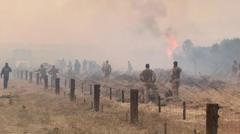The fire erupted late Thursday, affecting not only Heathrow but also causing power losses for nearby residents. By Friday morning, energy secretary Ed Miliband confirmed that the situation was under control but complications arose from the failure of backup power systems. Passengers were advised to stay clear of the airport and were cautioned that travel disruptions could last for days as airlines worked to rebook flights for approximately 290,000 affected travelers.
Heathrow Airport handles around 1,300 flights each day and serves over 80 airlines, making it a critical hub for international travel. As a result of the fire, many inbound flights were diverted to other airports, while airlines began canceling numerous routes. British Airways and Virgin Atlantic were among those redirecting flights and canceling services, urging passengers to avoid the airport until further notice.
In response to the heavy disruption, various airlines adapted their operations, including Ryanair, which announced an additional service to accommodate stranded passengers. The ongoing fire incident reinforces the intricacies of a global aviation system reliant on robust infrastructure, and its impacts are being felt across the globe as detailed reports of cancellations and rebookings continue to surface.
Travelers worldwide have shared their experiences of confusion and miscommunication as they navigate severe travel changes, with some making long journeys to alternative airports in search of accommodations.
With the enormity of the closure still unfolding, analysts suggest that the aftermath of this incident may take several days or even weeks to fully resolve. The incident serves as a stark reminder of the fragility of modern travel infrastructure in the face of unforeseen crisis events.
Heathrow Airport handles around 1,300 flights each day and serves over 80 airlines, making it a critical hub for international travel. As a result of the fire, many inbound flights were diverted to other airports, while airlines began canceling numerous routes. British Airways and Virgin Atlantic were among those redirecting flights and canceling services, urging passengers to avoid the airport until further notice.
In response to the heavy disruption, various airlines adapted their operations, including Ryanair, which announced an additional service to accommodate stranded passengers. The ongoing fire incident reinforces the intricacies of a global aviation system reliant on robust infrastructure, and its impacts are being felt across the globe as detailed reports of cancellations and rebookings continue to surface.
Travelers worldwide have shared their experiences of confusion and miscommunication as they navigate severe travel changes, with some making long journeys to alternative airports in search of accommodations.
With the enormity of the closure still unfolding, analysts suggest that the aftermath of this incident may take several days or even weeks to fully resolve. The incident serves as a stark reminder of the fragility of modern travel infrastructure in the face of unforeseen crisis events.





















